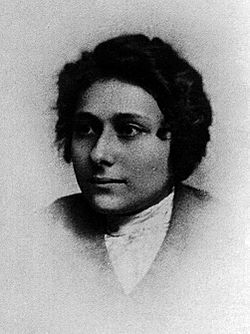María Blanchard facts for kids
Quick facts for kids
María Blanchard
|
|
|---|---|

Blanchard in 1909
|
|
| Born |
María Gutiérrez-Cueto y Blanchard
6 March 1881 Santander, Spain
|
| Died | 5 April 1932 (aged 51) Paris, France
|
| Known for | Painting |
María Blanchard (born María Gutiérrez-Cueto y Blanchard; 6 March 1881 – 5 April 1932) was a famous Spanish painter. She was known for creating her own special style of Cubism. Cubism is an art style where artists break down objects into geometric shapes.
Contents
About María Blanchard's Life
María Blanchard was born on March 6, 1881, in Santander, Spain. Her father was a journalist named Enrique Gutiérrez Cueto. Her mother was Concepción Blanchard Santisteban. She was also a cousin to the Mexican artist Germán Cueto.
María was born with some physical challenges. She had a curved spine and problems with her hips. This made her growth slow and she walked with a limp. Because of this, some kids at school teased her and called her "the witch." This made her feel very sad. She used painting to show these strong feelings. Her father was a big help to her. He always encouraged her to draw.
Her Art Education
In 1903, María moved to Madrid. She studied art at the Real Academia de Bellas Artes de San Fernando. She learned from Spanish artists like Emilio Sala and Manuel Benedito. Sala taught her to be very "precise" and to use "lots of color." These ideas became important in her early paintings.
In 1908, María won a third prize for her painting Primeros pasos (First Steps). This was at the National Exhibition of Fine Arts. Because of this, the government of Santander gave her money to continue her art studies. In 1909, she used this money to go to the Academie Vitti in Paris. There, she studied with Hermenegildo Anglada Camarasa and Kees van Dongen.
Discovering Cubism
In Paris, María learned about Cubist painting. She was inspired by artists like Jacques Lipchitz and Juan Gris. In 1914, World War I started, so María left Paris and went back to Madrid. She shared an art studio at her mother's house with some artists she had met in Paris.
In 1915, her art was shown in an exhibition. This show was put together by Ramón Gómez de la Serna at the Museo de Arte Moderno (Madrid). She was also asked to teach art in Salamanca (Madrid). But she did not enjoy teaching there.
Returning to Paris
In 1916, María moved back to Paris. She lived there for the rest of her life. In Paris, she met many Cubist artists. She started to create her own unique style of Cubism. She became very good friends with Juan Gris, who was also a Spanish Cubist painter. He had a big impact on her art.
María joined a Cubist art group called the Section d'Or. Her early paintings, like Woman With a Fan, showed flat, connected shapes. Over time, her style changed. Her paintings became more like real figures. They used bright, clashing colors and often showed sad feelings. Her artwork became very expressive and full of emotion.
Later Life and Challenges
After art shows in France and Belgium in 1920, and an exhibition in 1921, more people wanted María's art. She met important art dealers. But the economy was not good, so many collectors stopped buying her work. She depended on her friend, Frank Flausch, for money until he passed away in 1926. After his death, María was able to sell paintings to galleries in Paris and to a few private art buyers.
In 1927, her close friend Juan Gris died. This made María very sad and she became depressed. Her sister, Carmen, and her nephews came to live with her in Paris. This helped with her loneliness, but it made her financial situation worse. As her health got worse, María became more religious. She thought about joining a convent, but she never did. She kept painting to support her sister and nephews.
María's health slowly got worse over the next few years. She got tuberculosis, which made it impossible for her to paint. On April 5, 1932, she passed away in Paris at the age of 51.
Famous Artworks
- Composición cubista (Cubist Composition)
- Mujer con abanico (Woman with Fan)
- Nature morte cubiste (Cubist Still-life)
- Primeros pasos (First Steps)
- La Communiante (The Communicant)
María Blanchard's Legacy
María Blanchard's art was shown at the Botin Foundation in Santander, Spain, from 2012 to 2013. You can see her original paintings in museums like the Museo Nacional Centro de Arte Reina Sofía, the Hood Museum of Art, and the Courtauld Institute of Art. In 2021, the Prado Museum decided to buy her painting La Boulonnaise.
Juan Gris said that María had "talent." Jacques Lipchitz wrote that María "was a sincere artist." He also said her paintings showed "a painful feeling of unusual strength." Diego Rivera said her work was "pure expression."
Images for kids
See also
 In Spanish: María Blanchard para niños
In Spanish: María Blanchard para niños


